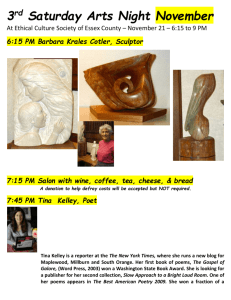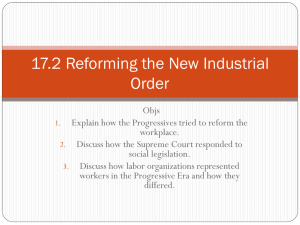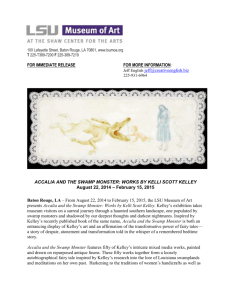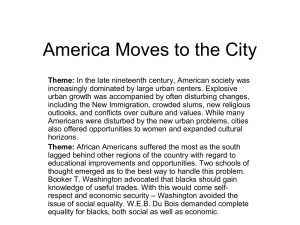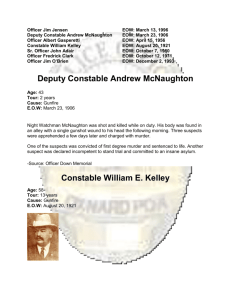AP Lang 101: The Rhetorical Analysis Question Objective
advertisement
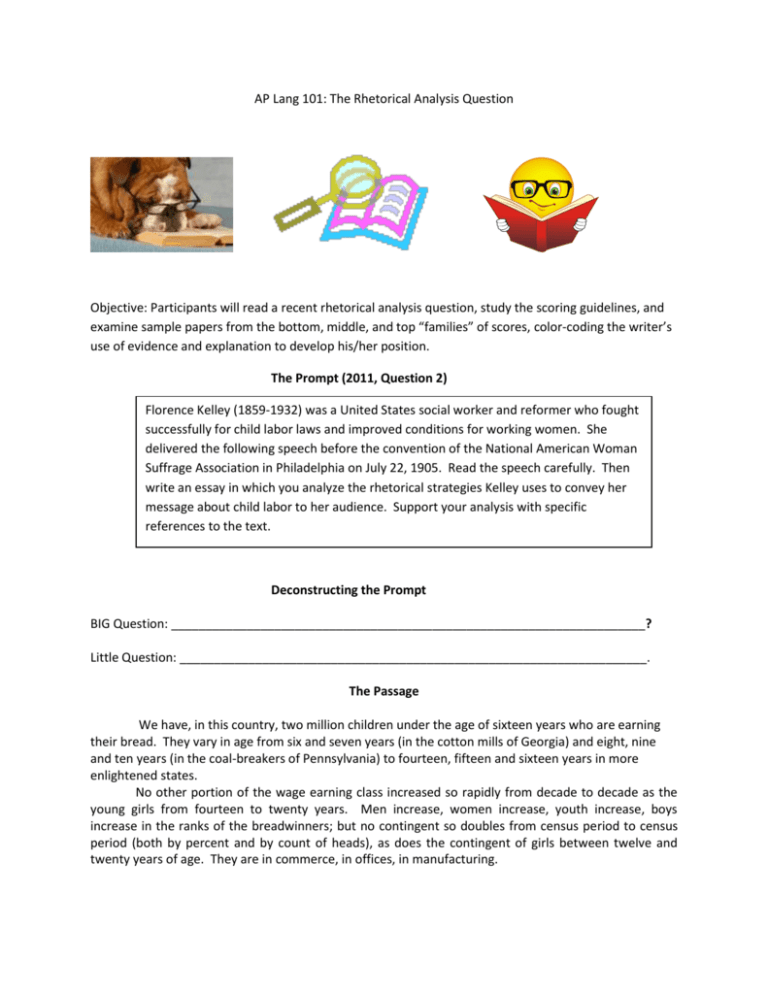
AP Lang 101: The Rhetorical Analysis Question
Objective: Participants will read a recent rhetorical analysis question, study the scoring guidelines, and
examine sample papers from the bottom, middle, and top “families” of scores, color-coding the writer’s
use of evidence and explanation to develop his/her position.
The Prompt (2011, Question 2)
Florence Kelley (1859-1932) was a United States social worker and reformer who fought
successfully for child labor laws and improved conditions for working women. She
delivered the following speech before the convention of the National American Woman
Suffrage Association in Philadelphia on July 22, 1905. Read the speech carefully. Then
write an essay in which you analyze the rhetorical strategies Kelley uses to convey her
message about child labor to her audience. Support your analysis with specific
references to the text.
Deconstructing the Prompt
BIG Question: _____________________________________________________________________?
Little Question: ____________________________________________________________________.
The Passage
We have, in this country, two million children under the age of sixteen years who are earning
their bread. They vary in age from six and seven years (in the cotton mills of Georgia) and eight, nine
and ten years (in the coal-breakers of Pennsylvania) to fourteen, fifteen and sixteen years in more
enlightened states.
No other portion of the wage earning class increased so rapidly from decade to decade as the
young girls from fourteen to twenty years. Men increase, women increase, youth increase, boys
increase in the ranks of the breadwinners; but no contingent so doubles from census period to census
period (both by percent and by count of heads), as does the contingent of girls between twelve and
twenty years of age. They are in commerce, in offices, in manufacturing.
Tonight while we sleep, several thousand little girls will be working in textile mills, all the night
through, in the deafening noise of the spindles and the looms spinning and weaving cotton and wool,
silks and ribbons for us to buy.
In Alabama the law provides that a child under sixteen years of age shall not work in a cotton
mill at night longer than eight hours, and Alabama does better in this respect than any other Southern
state. North and South Carolina and Georgia place no restriction upon the work of children at night; and
while we sleep little white girls will be working tonight in the mills in those states, working eleven hours
at night.
In Georgia there is no restriction whatever! A girl of six or seven years, just tall enough to reach
the bobbins, may work eleven hours by day or by night. And they do so tonight, while we sleep.
Nor is it only in the South that these things occur. Alabama does better than New Jersey. For
Alabama limits the children’s work at night to eight hours, while New Jersey permits it all night long.
Last year New Jersey took a long backward step. A good law was repealed which had required women
and [children] to stop work at six in the evening and at noon on Friday. Now, therefore, in New Jersey,
boys and girls, after their fourteenth birthday, enjoy the pitiful privilege of working all night long.
In Pennsylvania, until last May, it was lawful for children, 13 years of age, to work twelve hours
at night. A little girl, on her thirteenth birthday, could start away from her home at half past five in the
afternoon, carrying her pail of midnight luncheon as happier people carry their midday luncheon, and
could work in the mill from six at night until six in the morning, without violating any law of the
Commonwealth.
If the mothers and teachers of Georgia could vote, would the Georgia legislature have refused
at every session for the last three years to stop the work in the mills of children under twelve years of
age?
Would the New Jersey Legislature have passed that shameful repeal bill enabling girls of
fourteen years to work all night, if the mothers in New Jersey were enfranchised? Until the mothers in
the great industrial states are enfranchised, we shall none of us be able to free our consciences from
participation in this great evil. No one in this room tonight can feel free from such participation. The
children make our shoes in the shoe factories; they knit our stockings, out knitted underwear in the
knitting factories. They spin and weave our cotton underwear in the cotton mills. Children braid straw
for our hats, they spin and weave the silk and velvet wherewith we trim our hats. They stamp buckles
and metal ornaments of all kinds, as well as pins and hat-pins. Under the sweating system, tiny children
make artificial flowers and neckwear for us to buy. They carry bundles of garments from the factories to
the tenements, little beasts of burden, robbed of school life that they may work for us.
We do not wish this. We prefer to have our work done by men and women. But we are almost
powerless. Not wholly powerless, however, are citizens who enjoy the right of petition. For myself, I
shall use this power in every possible way until the right to the ballot is granted, and then I shall
continue to use both.
What can we do to free our consciences? There is one line of action by which we can do much.
We can enlist the workingman on behalf of our enfranchisement just in proportion as we strive with
them to free the children. No labor organization in this country ever fails to respond to an appeal for
help in the freeing of the children.
For the sake of the children, for the Republic in which these children will vote after we are
dead, and for the sake of our cause, we should enlist the workingmen voters, with us, in this task of
freeing the children from toil!
©2011 The College Board
Answering the BIG and Little Questions
Kelley’s message about child labor
“To call to her audience’s* attention the horrible
conditions” of ________________________
Kelley’strategies
“To work for reform of ____________________
laws”
“To call for the extension of ________________
______________________”
“To enlist the support of
_______________________ who could
_____________ in the child-labor law reform
movement”
*Identify her audience to the 5th slash: members of the National Woman Suffrage Association/
__________________________________________________________________________________
__________________________________________________________________________________
__________________________________________________________________________________
__________________________________________________________________________________
Studying the Scoring Guidelines
General Directions: This scoring guide will be useful for most of the papers you read. If it seems
inappropriate for a specific paper, ask your Table Leader for assistance. Always show your Table Leader
books that seem to have no response or that contain responses that seem unrelated to the question.
Do not assign a score of 0 or – without this consultation.
Your score should reflect your judgment of the paper’s quality as a whole. Remember that
students had only 40 minutes to read and write; the paper, therefore, is not a finished product and
should not be judged by standards appropriate for an out-of-class assignment. Evaluate the paper as a
draft, making certain to reward students for what they do well
All papers, even those scored 8 or 9, may contain occasional lapses in analysis, prose style, or
mechanics. Such features should enter into your holistic evaluation of a paper’s overall quality. In no
case should you score a paper with many distracting errors in grammar and mechanics higher than a 2.
Scoring Guidelines (Italicizing and underlining are mine.)
9 Papers earning a score of 9 meet the criteria for 8 papers and, in addition, are especially sophisticated in their
argument, thorough in their development, or impressive in their control of language.
8 Effective
Papers earning a score of 8 effectively analyze* how Kelley uses rhetorical strategies to convey her message about
child labor to her audience. They develop their analysis with evidence and explanations that are appropriate and
convincing, referring to the passage explicitly or implicitly. The prose demonstrates a consistent ability to control a
wide range of the elements of effective writing but is not necessarily flawless.
7 Papers earning a score of 7 fit the description of 6 papers but provide more complete explanation, more
thorough development, or a more mature prose style.
6 Adequate
Papers earning a score of 6 adequately analyze how Kelley uses rhetorical strategies to convey her message about
child labor to her audience. They develop their analysis with evidence and explanations that are appropriate and
sufficient, referring to the passage explicitly or implicitly. The writing may contain lapses in diction or syntax, but
generally the prose is clear.
5 Papers earning a score of 5 analyze how Kelley uses rhetorical strategies to convey her message about child labor
to her audience. The evidence or explanations used may be uneven, inconsistent, or limited. The writing may
contain lapses in diction or syntax, but it usually conveys the writer’s ideas.
4 Inadequate
Papers earning a score of 4 inadequately analyze how Kelley uses rhetorical strategies to convey her message about
child labor to her audience. These papers may misunderstand the prompt, misrepresent the strategies Kelley uses,
or may analyze those strategies inadequately. The evidence or explanations used may be inappropriate, insufficient,
or less convincing. The prose generally conveys the writer’s ideas, but may be less consistent in controlling the
elements of effective writing.
3 Papers earning a score of 3 meet the criteria for a score of 4 but demonstrate less success in analyzing
Kelley’s use of rhetorical strategies to convey her message about child labor to her audience. They are less
perceptive in their understanding of the passage or Kelley’s strategies, or the explanation or examples may
be particularly limited or simplistic. The papers may show less maturity in control of writing.
2 Little Success
Papers earning a score of 2 demonstrate little success in analyzing Kelley’s use of rhetorical strategies to convey her
message about child labor to her audience. These papers may misunderstand the prompt, misread the passage, fail
to analyze the strategies Kelley uses, or substitute a simpler task by responding to the prompt tangentially with
unrelated, inaccurate, or inappropriate explanation. The prose often demonstrates consistent weaknesses in writing,
such as grammatical problems, a lack of development or organization, or a lack of control.
1 Papers earning a score of 1 meet the criteria for a score of 2 but are undeveloped, especially simplistic in their
explanation or weak in their control of language.
0
Indicates an on-topic response that receives no credit, such as one that merely repeats the prompt.
Indicates a blank response or one that is completely off topic.
*For purposes of scoring, analysis refers to identifying features of a text and explaining how the author uses these to develop the
meaning or to achieve a particular effect or purpose.
Examining Sample Papers
Looking for Evidence and Explanation (The Quotation Sandwich)
TOP SLICE:
CLAIM
FILLING:
TEXTUAL EVIDENCE
BOTTOM SLICE:
EXPLANATION
College Board Student Performance Q & A (available on APCentral)
“Every analysis is actually an argument” in which students “must make claims about the text’s central
argument, its purpose, its appeals, and its tone, and then they must cite specific evidence from the text
to support those claims.”
Lower Half Papers:
Some were limited to “a narrow focus on her anger at child labor practices.”
They “asserted or described what Kelley said or did rather than analyzing
how her strategies worked to further her purposes.”
Some students argued rather than analyzed, “taking positions on child labor
themselves.”
Some “engaged in naming and listing rhetorical devices . . . without
addressing the “so what” question.” (My bolding)
Sample RR (1)
Child labor back in the 1800’s was unlawful and cruel to children. Children worked more than most
people in todays society work. Children could be killed doing their job, and they would be replaced.
There was no affect for what was going on.
Comments:
Not a ----- because ____________________________________________________________
Not a zero because ___________________________________________________________
Sample PP (2) {Little Success}
Kelly Florence usage of cataloging [?!!!] nation wide child labor conveys her her message that
action must be taken to clear the self consciences of every American by Freeing every child from the
shakles we chained them with and the saddle we rode with their cheap labor. She refrences the
common American ,who sleeps through the night , unaware of the twomillions children working
strainious hours on preparing or creating the products sold at local stores. Giving a consitat amount of
examples that include every place immaginable and inamanigable to child labor. Refering to her and
people moral views to help gain support to free the children from toil. Showing that child hood
experiences such as birthdays and freeness of mind are changed by the pitiful privilege of working as
adults on dangerous and unfitting machines. To capture ,yet again, the severity of the problem she
points to common items that everyone owns, has, or wears as a constant reminder of the overworked
children. Also refering to the Industries that accept and appoint children to manufacture products in an
unsafe industry as evil. As if the Industry had no concent or moral values to even attemp to restrict child
labor. The Question said, are the children slaves to our demands ,or are we slaves to constant demand
of cheap labor and affordable products.
Comments:
Lacking specific textual evidence (sandwich filling) and explanation (bottom slice)
Shifts to a “simpler task,” that of ________________________________________________
___________________________________________________________________________
Sample X (4) {Inadequate}
In this speech by Florence Kelley, she utilizes emotional appeal, personal connections through the use
of first person point of view, and repetition in order to affect change in her country’s policies about child
labor and women suffrage. She uses these techniques to rally strong support for child labor restrictions
and enfranchisement of women.
First, Kelley used a certain shock value that tugged at the hearstrings of her audience. Because her
audience was largely a crowd of women, these emotional appeals quite possibly strengthened support
for her causes. She states that little girls are working “in the mills in those states, working eleven hours
at night.” (line 30-31). This implies that young girls are being forced to work long hours without rest.
Kelley invokes a sense of guilt when she says, “The children make our shoes in the shoe factories; they
knit our stockings, our knitted underwear in the knitting factories.” This implies that while these women
are idly standing by without rights to vote, young girls are forced to do all the strenuous work. Kelley
uses several examples to both shock and guilt the audience into campaigning harder for the right to vote
and the right to save their daughters.
Secondly, Kelley uses first person point of view to show her personal connections and emotions on
the issues. She does not address the audience without placing herself in the reference as well. She says,
“we do not wish this …. But we are almost powerless.” (lines 78-80). This quote shows her desire to
connect herself to the crowd and provide a more personal touch to the speech. Also, this use of first
person eliminates any accusations of the audience. In essense, she is saying that the reason these poor
girls are stuck working in factories is because of the women’s inability to vote, which easily could have
sounded accusatory. However, her use of first person and referring to the crowd as “we” eliminates this
negative possibility.
Finally, Kelley utilizes repetition to provide special emphasis in her speech. When she refers to the
young girls’ forced labor, she says, “And they will do so tonight, while we sleep.” (lines 35). This quote
shows that women are basically doing nothing to help the poor factory children. While women are
neglecting to fight for the right to vote, their daughters must suffer. In Kelley’s speech, she says that the
women are sleeping while the children work three times. This repetition provides rhetoric, improving
the quality and rallying nature of the speech.
In conclusion, Florence Kelley utilizes a strong emotional appeal, first person connections, and
repetition in order to affect these women’s emotions. She used emotional appeal to strengthen
support; she used personal connections to ensure unity and prevent accusations; she used repetition for
emphasis and consistant flow of the speech. Kelley used these rhetorical strategies in order to ensure a
comradery and unity that would eventually lead to a major forward advance in both women’s rights and
labor laws in the United States.
Comments:
Follows a structure of organized analysis and identifies appropriate support (evidence)
Explanation of evidence (bottom slices): __________________________________________
___________________________________________________________________________
Insufficient analysis of strategies
---------------------------------------------------------------------------------------------------------------------------------------Sample UUU (6) {Adequate}
In Florence Kelley’s speech, she laments the injustices of child labor in the United States. She uses
logos, or logical appeal, and pathos, or appeal to the audience’s emotions, in order to convince them of
her point of view and make a strong argument. In her logical argument, Kelley uses facts such as state
laws and statistics. For her emotional appeal, she uses repetition, and also works to make the reader
feel guilty and bring them to action.
The first rhetorical strategy Kelley uses is logos, or an appeal to her audience’s logical side. She does
this by presenting facts that support her argument. In the first paragraph, Kelley states that “two million
children under the age of sixteen years” work to earn money. This statistic is meant to shock the
audience and provide a factual foundation for her claim. Throughout the entire speech, Kelley mentions
the laws in various states and regions of the United States that allow child labor. Society requires that
citizens follow these laws, but Kelley’s denouncing them makes them appear illogical and makes the
audience desire laws that are actually logical, as well as humane.
Kelley appeals to her audiences sense of humanity by using pathos, or emotional appeal. In her
speech, she repeatedly uses phrases about little girls working while everybody else sleeps. This
repetition engraves the image in the audience’s mind and makes everyone feel guilty for letting this
happen. Kelley draws on this sense of shame and states, “No one in this room can feel free from such
participation”(line 65-66), calling all the guilty passive people to action. Kelley also uses hypothetical
situations to create an image in the audience’s mind that is pitiful and horrifying. She mentions that a
child will begin working on their birthday. The contrast between the happiness of a birthday and the
harshness and severity of work shocks the audience. Kelley especially appeals to those in the crowd that
have children of their own, making them think, “What if that was my child?”
Kelley’s speech seeks to awaken the audience to the widespread horrors of child labor. She uses logos
in the form of factual statistics and state laws in order to appeal to people’s logical sides. She also uses
pathos in the form of repetition and hypothetical situations to instill a sense of guilt in the audience and
call them to action.
Comments:
Ways in which this essay differs from the 4 you just read: ____________________________
___________________________________________________________________________
Sample D (8) {Effective}
Working women and children fought for equal rights throughout most of the nineteenth and twentieth
centuries. Ironically, women and children were the ones subject to heinous, unimaginable working
conditions from an early age. Reformers, such as Florence Kelley, campaigned for equal conditions for
all people in the workplace. While her crusade obtained the support of many, the opposition to equal
conditions was immense and difficult to overcome. Speeches became a tool used to rally support for
the common cause, especially among women. Kelley’s speech at the National American Woman
Suffrage Association’s convention appeals to the sentiments of the listeners and utilizes emotional
examples in order to elicit a positive, as well as revolutionary response from the listeners.
The speech begins with a strong appeal to sentiment, urging an emotional response from the reader
after hearing heinous horror stories of young children trapped in horrid working conditions with no way
to escape. By making it nearly impossible for the listeners to disagree, Kelley captivates her audience
from the beginning. In addition, many listeners may experience a feeling of guilt after hearing “tonight
while we sleep, several thousand little girls will be working in textile mills.” After attempting to cause a
feeling of guilt, Kelley hopes the listeners will want to make a change or join the cause. Creating such a
rigid separation between the women and child laborers and the listeners results in feelings of sorrow
and the need to help or make a difference.
The vivid language and imagery employed by Kelley dramatizes the horror of the working conditions
without sounding overly descriptive. This imagery describes the working conditions as well as simple
objects, such as the hats made by the child laborers. Phrases such as “they spin and weave the silk and
velvet . . . stamp buckles and metal ornaments of all kinds, as well as pins and hatpins.” The vivid
imagery and descriptions allow the listener to imagine the children working, causing increased feelings
of sorrow. Consequently, the listeners can also imagine the poor conditions of a result of the imagery
and diction. Kelley may as employ a slight hyperbole, which is highly effective because it is not overly
dramatic and appeals to the emotions of the readers. The speech gives the impression that equally
horrid working conditions exist for all women and child laborers. While this may be a slight
exaggeration, it is effective considering this hyperbole makes the cause seem almost increasingly worthy
to the listeners.
Within the body of the speech, Kelley uses specific anecdotes of poor children and women working
under poor conditions. The use of specific examples makes the story more relatable as opposed to
hypothetical. Statements such as “New Jersey permits it all night long” and “in Pennsylvania, until last
May it was lawful for children, 13 years of age, to work twelve hours at night” make the experiences
seem common everywhere allowing the listeners to comprehend the importance of the issue at hand.
After utilizing several effective examples, Kelley begins a slight use of the dogged question. Throughout
the entire speech, Kelley assumes she is right with no room for error about the conditions of the
children and women working. By refusing to let readers disagree with her, Kelley becomes even more
revolutionary and effective in increasing the appeal of her cause. As a result, Kelley gives off the
impression that she is speaking for the people through lines such as “for the sake of the children, for the
Republic.” Therefore, the listeners almost have to believe her cause because she leaves no options for
the listeners. Something must be done because the horrors of poor working conditions have occured
for too long.
Overall, Kelley uses rhetorical devices heavily and impressively in order to appeal to the sentiments of
her listeners and evince the need for change in her society. From the beginning, Kelley does not leave
any room for doubt as she employs specific examples to illustrate the heinous working conditions. By
leaving no room for questions and making her listeners feel guilty without appearing overly forceful,
Kelley delivers a powerful message that succeeded in evoking positive and emotional responses from
even an ill-informed listener.
Comments:
What qualities bump this paper up from a 7 to an 8?
__________________________________________________________________________
YOUR TURN
Read Samples X, Y, and Z below. Answer the questions following each essay.
Sample X
In the late nineteenth century and early twentieth century, child labor was a major topic of debate.
Florence Kelley, a United States social worker and reformer, fought ardently against child labor and for
improved working conditions for women. In her speech before the National American Women Suffrage
Association, Kelley promotes an end to child labor and increased social reform. While Kelley conveys
her message through intentional forms of syntax and a call to action, she is most successful when by
appealing to pathos ethos to institute a true cry for change.
Kelley makes adequate use of syntax in order to prove her argument, most notably by her use of
parallelism. In describing all the difficulties and duties that child laborers must endure Kelley maintains
a constant pattern by her use of parallelism in order to emphasize the harsh realities of child labor. For
instance, Kelley states “The children make our shoes in the shoe factories, they knit out stockings [. . .].
They spin and weave [. . .]. They carry bundles of garments from the factories to the tenements, little
beasts of burden.” Therefore, by outlining the countless tasks that children are called upon to do, Kelley
engenders an emotional response in her audience. In short, Kelley’s successfully uses syntax and
parallelism to highlight the plight of the child laborers.
In addition, Kelley institutes a call to actions as her central purpose in order to send her message
and resolve the issues associated with child labor. For instance, Kelley state “we [. . .] are citizens who
enjoy the right of petition.” In giving the political rights of her audience, Kelley engenders a feeling of
necessity of action amongst her listeners. For, Kelley continues by saying, “no labor organization in this
country ever fails to respond to an appeal for help in the freeing of the children.” Kelley’s clear purpose
is to present a call for action against child labor. By motivating her peers, Kelley hopes that more and
more individuals will pick up the sword and fight child labor.
Lastly, Kelley is most successful in conveying her message by appealing to both ethos and
pathos. For example, in citing the ethical(ethos) issues of child labor, Kelley states “Tonight while we
sleep, several hundred little girls will be working in textile mills.” Kelley wants her audience to ponder
the rights and wrongs of child labor. By presenting a blatantly “wrong” concept, Kelley successfully
produces an uneasy feeling in her audience. This identification of injustice therefore serves Kelley’s
broader goals in combating child labor and instituting laws preventing the unethical treatment of
children. Also, by citing specific states and legislative bodies, Kelley details how the unethical nature of
child labor stems from the top of the political spectrum. Nevertheless, throughout her oration, Kelley
must often appeal to the
emotions of her audience in order to present her point. By pointing out how “two million children
under the age of sixteen years are earning their bread” and buy detailing the countless duties of a child
laborer, Kelley engenders an emotional and personal cry against child labor – her desired goal. Ergo, by
appealing to the ethics and emotions of her audience, Kelley conveys the true horrors of child labor.
Kelley calls her audience to take action against child labor “for the sake of the children.”
In attempts at garnering support for the implementation of child labor laws, Florence Kelley
utilizes numerous rhetorical strategies. Yet each different strategy comes together to form one
coherent idea – a cry for the complete and total destruction of child labor.
(1)
Into which “family” of scores does X fall? _____Top
(2)
Circle the position in which X falls in the family you chose:
TOP
MIDDLE
_____ Middle _____ Bottom
BOTTOM
9
6
3
8
5
2
7
4
1
(3)
Quote from the scoring guide a justification of your score based on each of the following:
(a)
analysis (including evidence and explanation): ____________________________________
__________________________________________________________________________
(b)
control of language: _________________________________________________________
__________________________________________________________________________
Sample Y
In the early 1900’s, young women were put to hard work in cotton and textile mills. Several
reformers like Florence Kelley fought successfully to improve working conditions for women and child
labor. She did this be delivering a speech to the National American Women Suffrage Association
(NAWSA). Through-out this speech, Kelley uses several rhetorical strategies to convey her message to
her audience.
Florence Kelley uses her point of view to diseingarsh on how women are being put to do more
work then they deserve (indecipherable word) that keeps them working all night. She states on how
when people sleep, young women are being put to work all night in textile mills and cotton mills. This
message shows the harsh treatment that womans get. It also show how they are being cut from there
rights by not being able to choose what they do. Instead, there forced to work under harsh treatment.
(1) Into which “family” of scores does Y fall? _____Top
_____ Middle _____ Bottom
(2) Circle the position in which Y falls in the family you chose:
TOP
MIDDLE
BOTTOM
9
6
3
8
5
2
7
4
1
(3)
Quote from the scoring guide a justification of your score based on each of the following:
(a)
analysis (including evidence and explanation): ____________________________________
__________________________________________________________________________
(b)
control of language: _________________________________________________________
__________________________________________________________________________
Sample Z
Throughout Florence Kelley’s 1905 speech to the Philadelphia Convention of the National
American Women Suffrage Association, she emphasizes the need to alter the existing working
conditions for young children as a necessary change in society. Repeating key concepts, introducing
numerous examples of horrendous conditions and state policies, and extolling the virtues of laws
curtailing the workday, Kelley develops a highly effective argument that pulls her audience into the issue
and invites them to join her efforts.
Utilizing forceful emotional appeals to the consciences of her audience, Kelley urges her
audience to empathize with the victims of the labor policies. For example, in the opening sentence of
her speech, Kelley gives the audience an idea of the scope of the problem that over “two million
children under the age of sixteen years” have to earn their own living. Through such a dramatic
reference to the population in question, Kelley commences her speech with a strong, jarring note that
forces her audience to care. Continuing in this vein, Kelley describes how “several thousand little girls”
work throughout each and every night in textile mills, slaving themselves over the production of
consumer goods. By noting the scale of the issue, Kelley sets the stage for her main argument, which
contrasts significantly with the existing laws of the land. By generating sympathy from her audience,
Kelley prepares them for this argument, effectively linking the problem with the state laws already in
place.
Kelley also crafts her argument with literary techniques and devices, which help place Kelley’s
suggestions in a more favorable light. In the body of her speech, Kelley uses parallel structure to start
each paragraph, emphasizing the similar injustice of the laws in “in Alabama,” “in Georgia,” and “in
Pennsylvania.” This notion of unfairness is furthered by her diction when she simultaneously praises the
Unites States as a “great industrial” country while condemning many state laws as a “great evil.”
Additionally, Kelley uses the oxymoron of “pitiful privilege” to describe the hypocritical nature of New
Jersey’s laws. Finally, she calls her audience into action with a transition from narration into firm
assertion. After describing the horrible nature of legislation “enabling girls of fourteen years to work all
night” and little girls and boys of “under twelve years of age” to spend their developing years in
factories, Kelley ties her ample evidence to her concrete goal: women’s rights. Including her audience in
her discussion, Kelley affirms that both the audience and she are in agreement together on the issue
when she asserts they “do not wish this.”
Throughout her persuasive speech, Kelley utilizes all the elements of effective rhetoric in her
proposal for women’s rights.
(1)
Into which “family” of scores does Z fall? _____Top
(2)
Circle the position in which Z falls in the family you chose:
TOP
MIDDLE
_____ Middle _____ Bottom
BOTTOM
9
6
3
8
5
2
7
4
1
(3)
Quote from the scoring guide a justification of your score based on each of the following:
(a)
analysis (including evidence and explanation): ____________________________________
__________________________________________________________________________
__________________________________________________________________________
(b)
control of language: _________________________________________________________
__________________________________________________________________________
__________________________________________________________________________
